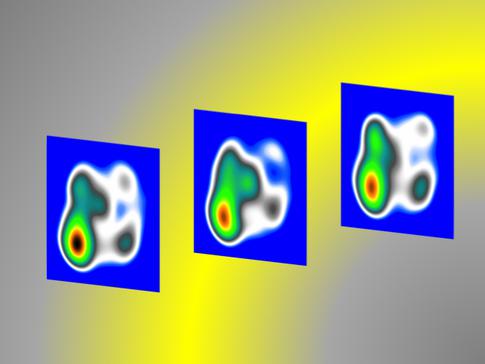XFEL: New paths for surface research
New paths for surface research

Molecular adsorbates on solid surfaces form hybrid organic-inorganic materials whose properties are of great benefit for applications in optoelectronics, catalysis, or energy storage. Photoelectron microscopy can be used to visualize the electronic orbitals of molecules with atomic resolution. The shape of the orbitals provides new insights into the properties of hybrid organic-inorganic materials.
"We have extended this technique to the time domain to study dynamic processes at the hybrid interface that occur within a few picoseconds of optical excitation," says Daria Gorelova, a professor at Universität Hamburg and in the Cluster of Excellence "CUI: Advanced Imaging of Matter."
To understand the interplay between charge, electron and structural dynamics, the researchers of European XFEL, DESY and the universities of Hamburg, Würzburg, Kiel und Freiberg studied photoexcited pentacene molecules adsorbed on a silver substrate. At FLASH they obtained snapshots of molecular orbitals and high-precision details about the electrons in the very fast reactions. To interpret these data, the team developed a theoretical description combining experimental data with calculations. This revealed details of fast intramolecular electron and structural changes at the surfaces.
"Ultrafast momentum microscopy will provide unprecedented insight into photon-triggered dynamics and open new avenues for surface research," says Markus Scholz, scientist at FLASH. Anders Madsen, co-author of the publication and leading scientist at European XFEL adds: “This method paves the way for further applications at free-electron lasers and enables the development of new functional materials with tailor-made optical and electronic properties.”
"We are very pleased about the successful experiment at DESY," says European XFEL Scientific Director Serguei Molodtsov, who is also professor at the University of Freiberg and one of the authors of the paper. "At European XFEL, we are currently building a momentum microscope for photoelectron spectroscopy using a shorter wavelenths, which will complement the research at FLASH and provide even more information about hybrid structures."
Reference
Kiana Baumgärtner, Marvin Reuner, Christian Metzger, Dmytro Kutnyakhov, Michael Heber, Federico Pressacco, Chul-Hee Min, Thiago Peixoto, Mario Reiser, Chan Kim, Wei Lu, Roman Shayduk, Manuel Izquierdo, Günter Brenner, Friedrich Roth, Achim Schoell, Serguei Molodtsov, Wilfried Wurth, Friedrich Reinert, Anders Madsen, Daria Popova-Gorelova, and Markus Scholz
“Ultrafast orbital tomography of a pentacene film using time-resolved momentum microscopy at a FEL”
Nature Communications
DOI: 10.1038/s41467-022-30404-6.
